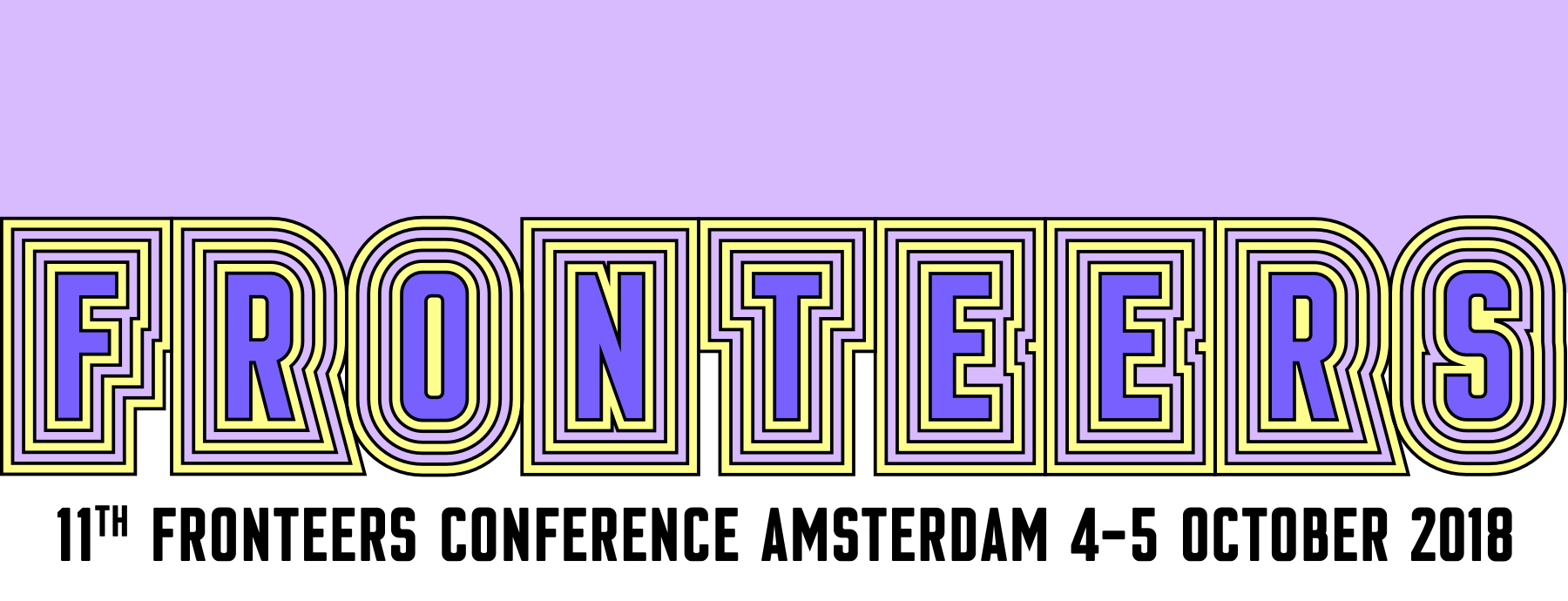Speakers · Fronteers Conference 2018
We have a spectacular line-up of 16 speakers and 1 MC for you. These are the people who'll be stimulating your mind with thought-provoking talks:
Your host: Martin Splitt

The host of Fronteers Conference 2018 is Martin Splitt, completing the Fronteers Conference on-stage trifecta, by returning after a talk in 2016 and a lightning talk in 2017.
Martin is pretty decent at humaning and pretty good at computering, so he decided to use his computering to improve his and others’ humaning. He loves the open web and open source and helps to make things better with, but not limited to, code.
Ruth John

Ruth is a creative engineer with a web development background. She has enjoyed a fifteen year career working on websites, applications and most recently interactive art projects, especially those featuring audio. She also educates people. As a Google Developer Expert and founding member of { Live : JS } she’s almost always got a conference talk lined up, article ready to be published or live show tour date in the diary.
How to Be a Web A/V Artist
Come and be fascinated by the world of audio visualisation in a browser. This isn’t just about creating stunning data vis to music! We see how we can pipe data realtime into custom properties to enhance our visuals. The speaker re-addresses how we analyse sound via the Web Audio API and proposes a better way of processing the data to better suit music. And, to top it all off, we harness the Web MIDI API for full hardware control as well. You may not think it, but this really is a talk with a great deal of take-aways and new techniques for you to consider in your coding life.
- JavaScript
- Audio
- Animation
Eva Ferreira

Evangelina Ferreira is a front-end developer and teacher. She currently works as a UI Developer and has been teaching web technologies at the National Technological University of Argentina for more than five years.
Throughout her career Evangelina has been deeply involved in the Argentinian web community. She enjoys giving workshops and talks and since 2015 she has been organizing CSSConf Argentina, an international non-profit event that brings experts from all around the globe to speak about web technologies.
In her spare time she loves reading about CSS, creating animations and playing with her cats.
The “C” is for Accessibility
Screen readers, semantics, label tags, aria and alt attributes… All these things are essential instruments of accessibility; but so are contrast, visibility, pseudo-elements and many others. CSS’s impact on users with disabilities is many times underestimated, which leads to deficiently written code that affects the lives of many of our users.
In this talk we will learn how our CSS code affects accessibility and how we can write more responsible stylesheets.
- Accessibility
- CSS
Laura Carvajal

Laura Carvajal is a Principal Engineer at the Financial Times and is the former accessibility lead for FT.com. Laura has been working in web development for the past 15 years.
But my site looks fine! Common ways we break accessibility and how to avoid them
A great deal of what makes a website accessible is fairly straightforward to achieve, but only once we know what to look out for! So many websites are broken for disabled users, including those who rely on assistive tech, such as screen readers and magnifiers, to navigate the web. That's a good 10%-20% of your user base who can't access your content or pay for your product, even though they may want to.
In this talk we will go over some common front-end (anti)patterns and how they affect accessibility while otherwise going virtually undetected. We will see real user testimonials of how these affect their interaction with the web and their daily lives. Lastly, we'll cover how to get the same results without breaking your site for disabled users, including real-life examples of how we've we've avoided these pitfalls at The Financial Times.
- Accessibility
Mathias Bynens

Mathias works on the V8 team at Google, and helps evolve the ECMAScript standard at TC39.
He's a veteran speaker, and a Fronteers Conference veteran to boot; 2018 marks his 4th appearance on our main stage since 2011. We're glad to have him back.
V8 internals for JavaScript developers: optimizing array operations
This presentation demonstrates how learning just a little bit about JavaScript engine internals can help you improve the run-time performance of your JavaScript code — not just in V8 specifically, but across all JavaScript engines!
- V8 internals for JavaScript developers
Espen Brunborg

Based in Oslo, Norway, Espen has spent the majority of his career bridging the gap between traditional graphic design and the internet. He is co-founder of Primate, a small Edinburgh based web agency driven by a love of creativity, curiosity for technology, and a belief that great clients are born from honest relationships.
The Secret Life of Comedy
It has never been easier to make a web site, and our digital toolbox has never been greater. At the same time, we seem more concerned with automating our process and systemising design than with creative thinking and generating ideas. Is web design purely about utility? Is it all about convention? Is it a science? Or is there room for beauty, expression and art?
In this talk, Espen will take a tongue-in-cheek look at the state of web design, explore different creative mindsets, and show how adding a pinch of comedy can make a real difference to the bottom line.
- Design
Chris Lilley

Chris Lilley is a Technical Director at the World Wide Web Consortium (W3C). Considered “the father of SVG”, he also co-authored PNG, was co-editor of CSS2, chaired the group that developed @font-face, and co-developed WOFF. Ex Technical Architecture Group. Chris is still trying to get Color Management on the Web, sigh. Currently working on CSS levels 3/4/5 (no, really), Web Audio, and WOFF2.
Everything Changes
70% of websites use downloadable fonts now, at least at a basic level. But with CSS Fonts 4 support for OpenType Variable Fonts — a single font file that behaves like multiple fonts, or even an infinity of morphing fonts — and for restyling the palette of Color Fonts, the capabilities opening up for typography on the web are extraordinary. In this session, Chris Lilley explains the most recent, cutting-edge developments and also recaps OpenType font features from CSS Fonts 3, to further improve typography with CSS. Learn what's possible today, and in the near future.
- Fonts
- CSS
Sebastiaan de With

Sebastiaan de With is an ex-Apple designer that has recently designed Halide, a new take on an iOS camera app. When he isn’t designing Halide, he does contract work for Google, Mozilla, Sony and Apple.
Designing Halide: A Tactile Camera App
Follow the journey of Sebastiaan de With, designer of Halide, as he sets off with his partner Ben Sandofsky to reimagine what a camera app on iOS can be. A story with anecdotes from his time working as a designer at Apple to hard lessons learned while designing a camera app with a fresh approach.
- Design
Nickolas Means

Nick is infatuated with disasters of all kinds and the amazing things we can learn from them. When he's not stuck in a Wikipedia loop reading about plane crashes, he spends his days as a Senior Engineering Manager at GitHub. He works remotely from Austin, TX, and spends most of his spare time hanging out with his wife and kids, going for a run, or trying to brew the perfect cup of coffee.
How to Crash an Airplane
On July 19, 1989, United Airlines Flight 232 was en route to Chicago when a mechanical failure caused the plane to become all but uncontrollable. In this unsurvivable situation, the flight crew saved more than half of those onboard. How did they do it?
Flight crews and software teams have a lot in common, and there’s much we can learn from how the best crews do their jobs. What can we learn from the story of United 232? While this talk won’t earn you your pilot’s license, you’ll definitely come away with some fresh ideas on how to make your team even more amazing.
- Inspirational
- Teamwork
Stefan Judis

Stefan started programming 7 years ago and quickly fell in love with web performance, new technologies, and accessibility. He worked for several startups in Berlin and is now with Contentful to tell the world how an API-first CMS can make you a bit happier.
He is also a curator of the web performance online resource Perf Tooling, organizer of the Web Performance Meetup Berlin, contributes to a variety of open source projects and enjoys sharing nerdy discoveries.
What the v...DOM?
Everybody talks about the vDOM and all the modern frameworks like React and Preact use it, but who knows what it is and how it works? How virtual is it in reality? And why does it work so well? Let’s have a detailed look at the vDOM, its internal mechanisms and bring some light into the topic by building yet another vDOM library.
- JavaScript
- vDOM
Heydon Pickering

Heydon is a designer and writer focused on inclusive and ethical design for the web. He has worked with Bulb Energy, The Paciello Group, and The BBC, and he is an editor with Smashing Magazine. He recently self-published a book on inclusive component design, available at the aptly named book.inclusive-components.design. He is currently interested in native web components and their role in performant and framework agnostic design systems.
Get Your Priorities Straight
We are not blessed with infinite resources, so when we make things for the web we have to decide what gets done and what doesn't. But what we choose to prioritize isn't always what deserves to be a priority. This talk explores the spurious thinking, the privileges and the prejudices, behind our faulty prioritizations and defends inclusive design as the ultimate priority when building interfaces.
- Accessibility
Estelle Weyl

Estelle Weyl is a freelance web developer, speaking and teaching about web development. An internationally published author, her books have been translated into over 14 languages. She's been coding CSS, HTML, JavaScript and PHP since 1999, tableless CSS since 2003. Estelle blogs at the invaluable Standardista. We’re chuffed she’s agreed to return to Fronteers Conference after her talk at our 2016 Spring Conference.
Fast to Code. Fast to Load.
It doesn’t have to be an either/or situation. All sites should be fast to load, responsive, internationalizable, secure, and performant. It makes sense to use all available tools to quickly implement features, but some of the tools negatively impact usability. In this session we address the issues of creating sites without compromising any under the hood requirements.
- Performance
Chiara Aliotta

Chiara is the mind, face, and heart of Until Sunday. She’s an Italian award-winning designer with years of experience as a graphic designer, art director, and brand consultant. Her work is creative, emotionally engaging, and detail-obsessed.
During her time as a freelance art director, Chiara has created innovative designs for Joomla, CTA, Daelmans, NH Hotel, Osram, and many others.
She has also overseen the creation of the artistic style and brands of tech companies and not-for-profit organisations around the globe, ensuring their communications followed the established vision and mission. Chiara describes herself as passionate about typography, colours, and good design. She writes articles about the beauty of typography and the importance of great design.
I put a spell on you
"Designers have a very unique power, and as Uncle Ben tells us in the original Spiderman movie, with great power comes great responsibility. Using our magic, we are capable of controlling or limiting users’ actions and behaviour, both on a physical and emotional level. The question is: how do we use our skills? Do we deceive our users to achieve some predetermined goal? Do we take advantage of our strengths and knowledge to get what we want from them, no matter the cost?
Persuasive design can be likened to ‘white magic’. It can improve the users’ journey and win us the trust and approval of our target audience, without using black hat design and devious tricks.
In this fascinating and dynamic presentation, I will invite designers and decision makers to examine their powers, to embrace and honour our call as ‘shapers of behaviour’ and purveyors of ‘white magic’."
- UX
John Wilander

John is a WebKit Security Engineer at Apple. He holds a PhD in computer science with focus on software security and has been working in security and privacy since 2001, including six years as chapter leader in the Open Web Application Security Project.
His most recent work involves new developer-facing browser features to defend against speculative execution attacks and the design and implementation of Safari’s Intelligent Tracking Prevention. Outside open source coding on WebKit he’s into music production and fiction writing, about hackers of course.
Privacy by Default on the Web
The web is better when user privacy is respected and protected. Join us to uncover the startling repercussions of cross-site tracking on the web ecosystem and get a peek at Apple’s anti-tracking technologies in Safari and WebKit. Learn how these innovative privacy features work to protect users while ensuring the web still works for them. Then find out what you can do as a web developer to further protect user privacy in your web apps.
- Safari
- Privacy
- Intelligent Tracking Prevention
Paul Verbeek-Mast

Paul is a Senior Software Engineer at Confrere, based in The Netherlands, and organiser of the NLHTML5 meetups. He’s passionate about welcoming everyone into tech and making the web work for everyone.
Over 10 years ago, Paul was a .NET developer, but after going to his first front-end developer conference, he fell in love with that community. Ever since then, he's been an active member of the front-end community, volunteering at, speaking at and organizing different conferences.
Nowadays, he gives talks about ethics, diversity, and inclusivity, to help make everyone feel as welcome as he was 10 years ago.
PS. He's unreasonably proud of his personal website.
The Reasonable Developer
In the 1800s, an astronomer came up with the definition of "L’Homme Moyen", the average man. His studies, on the way the average person behaves, are still being used in legal trials today to determine whether someone’s action was reasonable. They call this The Reasonable Person Standard.
As developers, we make ethical decisions almost on a daily basis. Most of them are subconscious. And with machine learning, we’re even training machines to make ethical decisions. But a lot of the time, we ignore the ethical dilemmas and go for the easiest, fastest route. It's time to think about our responsibilities and how a reasonable developer would behave.
- Ethics
Chris Gannon

Chris is an independent interactive designer, illustrator and animator. His love of motion graphics and minimal, interactive 2D vector art has led him to become something of an expert in web animation and his boundary-pushing work exploring the wonderful and often frustrating world of Scalable Vector Graphics (SVG) has been recognised with two industry awards for innovation and experimentation.
The Almighty Rabbit Hole
Inspiration - it's the unquantifiable thing that takes us from nowhere to somewhere - even if that somewhere turns out to be nowhere else the journey to that nowhere is often just as useful as arriving at somewhere. I haven't taken my meds today.
And it's difficult to get inspired sometimes. We often make the mistake of looking at our own industry for answers and ideas which leads to regurgitation and me-too-ness.For us to stay interested in our careers we need try new things and experiment. And the first step on our path to the next step is inspiration.
My talk is about the rabbit holes I go down, what I find down there (spoiler alert: sometimes it's just rabbit sh*t) and where they lead. I prefer not to give advice but if you can use some of my methods and apply them to your own work then I'll be happy (and so will you, hopefully).
- JavaScript
- SVG
- Animation
Kenneth Rohde Christiansen

Kenneth Rohde Christiansen is a Danish software engineer and architect, specialized in mobile and web technology. Working at Intel out of Copenhagen, Kenneth helps define Intel’s strategy and plans regarding the Web Platform, as well as puts it into action. Before joining Intel, Kenneth was employed by Nokia (Denmark and Brazil) where he worked on the Nokia N9 web browser, Qt, WebKit, as well as many other mobile projects.
Kenneth is an elected member of the W3C Technical Architect Group (TAG).
Currently working on Progressive Web Apps and emerging web standards like Web App Manifest, Generic Sensors, Web NFC etc.
Bridging the web and the physical world
The improvements in size, features and price of hardware has ushered new opportunities in creating small, smart devices (aka internet-of-things). Installing an app for one such devices might seem fine at first, but it doesn’t scale with a multitude of devices.
With the web getting new capabilities such as Web Bluetooth, USB and the like, there is a new opportunity. Come join me for a look at how the web can make your smart devices success!
- JavaScript
- Hardware
- Web Bluetooth
- Web USB
